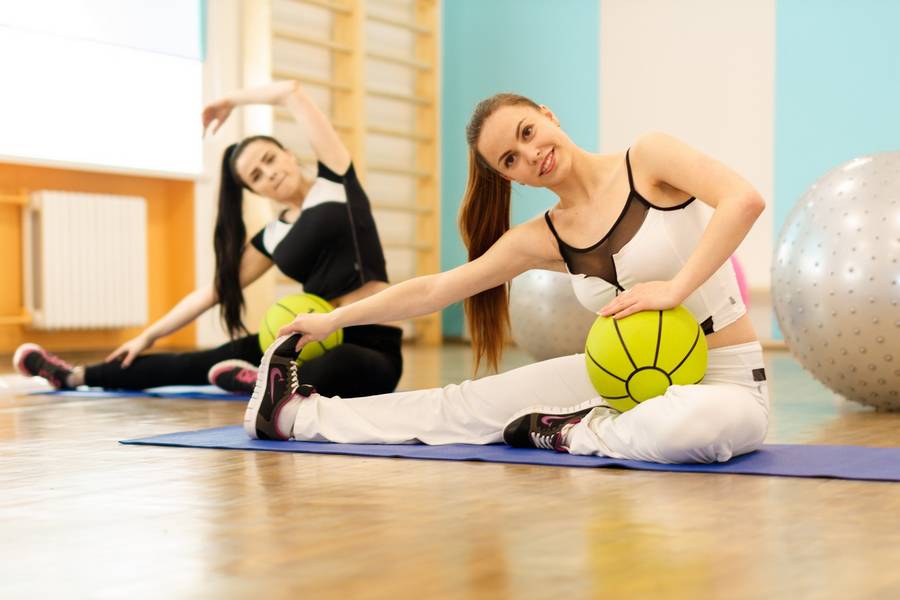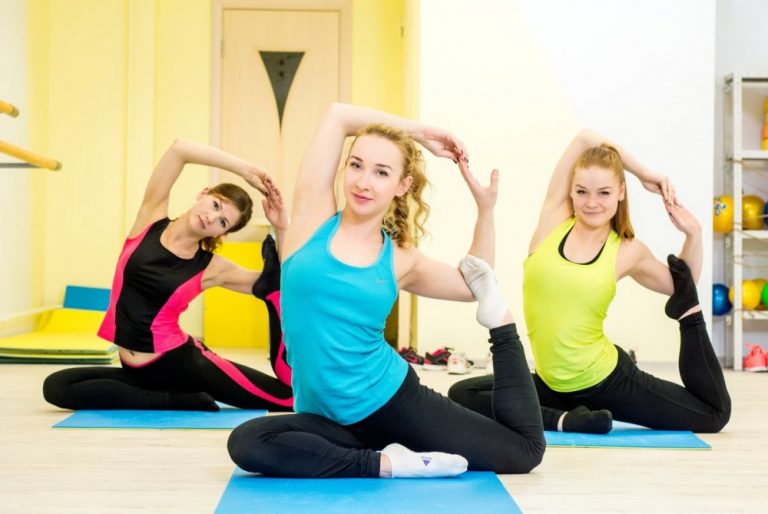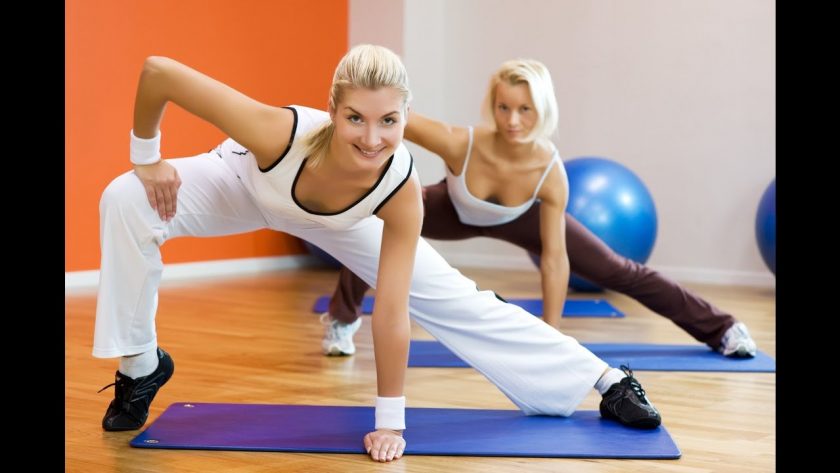Aerobics is fitness training for the whole body. The exercises, usually put together in a choreography and performed by an aerobic trainer, are classically a mix of gymnastics and dance .
Therefore, aerobics is often labeled as a sport for women or girls – wrongly! Because now there are numerous forms and sub-forms of this group training, which more and more men are getting excited about.Whether step aerobics, kick power, body toning, BodyPumb or ball corrobics – aerobics has many faces. It is true that (aerobic) endurance and coordination are primarily trained, but every form of aerobic exercise has its own focus and training goals .
In addition to traditional aerobic steps and dance elements, the workout consists of dynamic martial arts and aerobic elements, intensive strengthening exercises and demanding coordination training. Often various aids such as platforms or step boards, barbells and balls are used.
Aerobics is often ridiculed and underestimated. This may be due to the fact that when it comes to aerobics, some still see Jane Fonda’s fitness videos from the 80s. In the meantime (luckily) nobody wears tight bodies with neon-colored cuffs and headbands.

More and more men are also discovering aerobics or workouts with aerobic elements for themselves. And that’s just as well! After all, women are no longer advisable in the weight room …
Aerobic training can be extremely strenuous and sweaty be. The demand for endurance, coordination and memory (to remember the choreography) is also higher than in many other sports.
And what about calorie consumption? How many calories do you actually burn during aerobic exercise? Can you lose weight with aerobics?
Calorie consumption during aerobics
The energy turnover, i.e. the amount of energy that a person has to maintain his life processes, is an individual matter. Factors such as age, gender, body weight, height and muscle mass influence the calorie consumption.
Therefore, the calorie consumption in aerobics cannot be determined uniformly for every person. One possibility to compare the energy consumption in different activities is the so-called ” Metabolic Equivalent “.
That sounds complicated at first, but it isn’t.
1 MET describes the calorie consumption of 1 calories (kcal) per kilogram of body weight per hour (1 MET = 1 kcal / kg / hour). One MET corresponds roughly to the body’s resting metabolic rate, e.g. the energy expenditure when sitting quietly.
Another definition of the MET is the oxygen turnover: 1 MET corresponds to 3.5 ml of oxygen per kilogram of body weight per minute (1 MET = 3.5 ml of oxygen / kg / min).
The first definition can be used to calculate the calorie consumption of various physical activities, including aerobics.
In general it can be said that moderate physical activity has an energy expenditure of around 3 to 6 METs. Intensive efforts, on the other hand, achieve METs above 6.
The “Compendium of Physical Activities” provides the METs for a number of different activities. The individual activities can be identified using a five-digit code (e.g. ” 03 015 “). The first two digits describe the category (e.g. 03 for “dancing”), the last three digits the description of the activity (e.g. 015 for “aerobics, general”).
The following table shows the METs for various aerobic activities:
The following formula is used to calculate the calorie consumption:
Calorie consumption in kcal (per hour): MET * weight in kg
Example: A person weighing 70 kg would burn about 350 calories per hour during aerobics with low impact (low load) (calculation: MET of 5.0 * 70 kg).
For a more accurate calculation of the calories consumed in aerobics, one can calculate:
Calorie consumption in kcal: (MET * weight in kg) * (time in min / 60)
Example: A 30-minute aerobic training session with high impact (high load) consumes about 256 calories with a body weight of 70 kg (calculation: (MET of 7 , 3 * 70kg) * (30 min / 60) = 511 * 0.5 = 255.5 kcal).
If you don’t feel like doing arithmetic, you can download this Excel table: Simply enter your body weight and duration of the sports unit and read off the calorie consumption of the various aerobic activities!
Important: When calculating the energy consumption, only the time in which you are in motion should be taken into account. So just the pure exercise time without breaks.
In addition, the comparison of activities (such as aerobics) using MET is only suitable for the relative comparison of the energy consumption of a person , since the energy expenditure is individually different. The METs are only averages. In order to determine the exact energy consumption, factors such as body weight (possibly overweight), age, gender, exercise efficiency, as well as the geographical and environmental conditions in which the activity is carried out, must also be taken into account.
Accordingly, the actual calories burned for the same aerobic activity can vary from person to person. However, the METs are well suited for determining the relative calorie consumption of a person during aerobics.
Can you lose weight with aerobics?
Aerobics is movement and every movement promotes calorie consumption . The big advantage of aerobics compared to many other sports: Training in a group and making music that is motivating
As with any physical activity, aerobics can help achieve a negative energy balance to achieve. For this, the calorie consumption must exceed the calorie intake (through food). Only then is it even possible to lose weight!
Losing weight with just a little aerobic exercise is difficult, however. As the example calculations mentioned above have shown, the amount of calories consumed in aerobics is not always as expected.
An hour of aerobics with low impact burns “only” 350 calories . That’s just the equivalent of a small croissant.
In addition to training, nutrition plays an at least as crucial role for weight loss success. After all, both sides have to be right for a negative calorie balance: the calorie intake and the calorie consumption. Using aerobics as the only measure to lose weight is likely to be a lengthy affair – unless you feel like doing several hours of aerobics a day …
However, when combined with a balanced diet, aerobics is an excellent way to shed excess pounds. The good news:
Even relatively short but intensive training units are enough to sustainably increase calorie consumption. Even half an hour of high impact aerobics burns around 250 calories with a body weight of 70 kg!
Prerequisite: Aerobic training takes place regularly! We recommend three to four training units per week of 30 to 60 minutes . Longer aerobic sessions (45 to 60 minutes) with a rather low pulse rate of around 130 are particularly suitable for losing weight. Longer endurance training at low levels of stress effectively attacks the fat reserves.
Many gyms offer aerobics classes of various intensities and difficulty levels. It is best to get advice beforehand which course is particularly suitable for achieving your personal training goals.
Which aerobic training burns particularly many calories?
Basically: the higher the MET, the higher the load and the calorie consumption. In general, it can be said that aerobic classes with low impact use fewer calories than high-impact workouts.
Particularly good for weight reduction are e.g. Step aerobics and dance aerobics with additional weights . Both types of aerobics provide ideal endurance and strength training that burns a lot of calories.
The intensity can be increased with the height of the step board and higher additional weights. Depending on the training status, increases in training duration and intensity are possible over time.

The right diet to lose weight
Despite regular aerobic exercise, diet should not be neglected.
Those who train AND eat healthily improve their weight loss results. Instead of strict prohibitions and strict rules, training should be accompanied by a long-term change in diet .
The basis should be lots of vegetables and plenty of fluids (calorie-free, preferably water). Vegetables contain plenty of fiber, which makes you feel full and low in calories.
Fresh fruit, low-fat dairy products, as well as high-fiber grain products, low-fat meats, fish and healthy vegetable fats ensure variety on the menu.
Above all, low-fat proteins , such as chicken and turkey breast, pollack fillet, grainy cream cheese, Harz cheese & Co., in addition to plenty of vegetables, ensure a high degree of satiety, which prevents food cravings.
Small sins can be quickly compensated for with an extra aerobic session. The following applies to both training and nutrition: We only lose weight if we can do both to integrate permanently into his everyday life .


